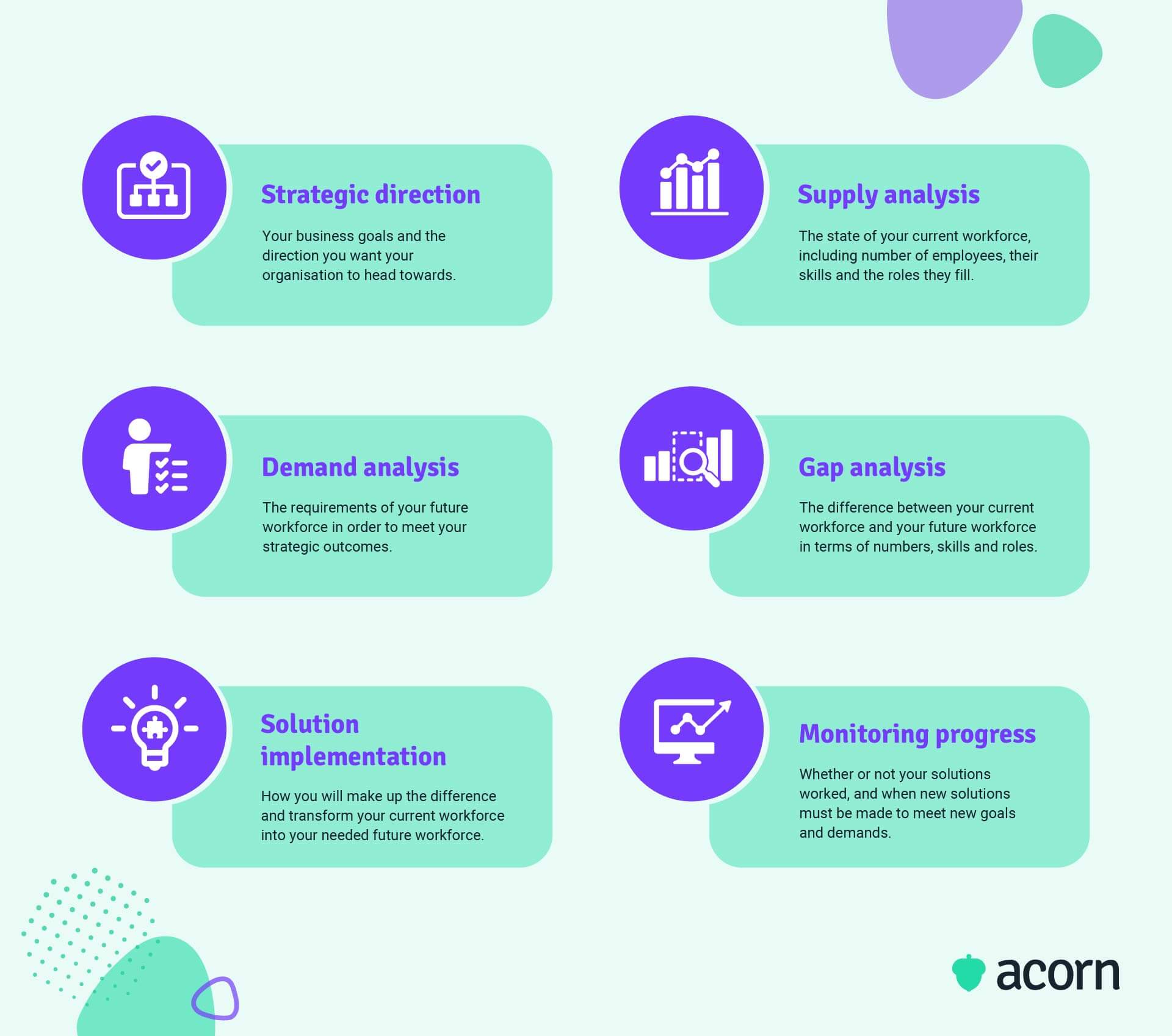A Look at the Workforce Planning Process
Reading Time:

Lead the pack with the latest in strategic L&D every month— straight to your inbox.
SubscribeSo, you want to make your organisation future-ready and prepared for whatever the world might throw at it.
There’s no better way to do that than with strategic workforce planning. Where does one start, though? By understanding what the workforce planning process actually is.
So, what is workforce planning? How does it work, what are the steps, and why do you need to follow a process in the first place? This guide answers everything you need to know about what it is and how to use it,
What is the workforce planning process?
The workforce planning process is a simple step-by-step method of approaching workforce planning (WFP). It covers your organisation’s progress from the initial planning phase through to analysis, forecasting, design and implementation, for the end purpose of aligning your current workforce and its capabilities with your overall business strategy.
The importance of following a workforce planning process
So why should you have to follow a WFP process? Do you really need such a strict method to stick to? Well, yes. There are certain steps to WFP that need to be followed to make sure your process is efficient and effective.
The steps in the WFP process ensure that you cover all the necessary bases needed for you to successfully plan your workforce. If you skip one entirely then you won’t end up with all the information you need. After all, how can you know what you need to change for the future if you haven’t taken the time to find out what you have in the present? The WFP process is there as a guideline to help you collect all the information you need to conduct your workforce planning strategy.
6 stages of a successful workforce planning process
Now that you know what a WFP process is and why it’s important to follow one when executing workforce planning in your organisation, you’re probably wondering how the process itself actually works. There are six core steps to getting your WFP process underway.
- Strategic direction
- Supply analysis
- Demand analysis
- Gap analysis
- Solution implementation
- Monitoring progress

Strategic direction
First, you’ll want to work out your organisation’s strategic objectives and direction. Ask yourself: Where do you want your business to be going? What are your goals for your business in the future? Before you can start planning your future workforce, you need to know what goals and visions you’re trying to work towards. Without this goal, you’ll have no direction for your WFP process to reach for.
Supply analysis
The next step is to analyse your current workforce. Look at the talent you currently have employed in your organisation. What are the skills and capabilities of your existing workforce? What roles do you employ? Don’t forget to analyse how many employees you have altogether, or how many are in each specific role. Make sure you keep all your collected data recorded and readily available. That way you can look back at it as historical data when you engage in WFP in the future.
Demand analysis
Once you’ve finished your supply analysis, you can start on demand analysis. Think about your strategic focus—what goals you set for yourself in the first step. Now think about scenario planning, your future workforce and what it needs to look like in order to deliver on those goals.
Is your desired future going to require certain skills? More people? Different roles? In other words, you need to understand your future workforce needs if you want to go about effective workforce planning. Your findings at this step will be absolutely critical in determining future workforce and reaching your business outcomes.
Gap analysis
Now you need to figure out what’s missing. You know what you have, and you know what you’ll need to have in the future. So what are the missing elements or “gaps” between the two? How big are these workforce gaps? Which gaps should be filled first? This is where you’ll need to think of your workforce strategy and make strategic decisions with a long-term focus.
Solution implementation
Once you know what your gaps are, it’s time for you to begin implementing solutions. You need to work out what you need to fill in those missing elements in order to get your organisation from where it is now to where it needs to be. Will you need to make new roles for new people to make way for new developments in your business’s industry? Provide training in new skills and capabilities? Will you need to prepare for an ageing workforce, mass retirement, future staffing and succession planning? Your decision-making here will be vital to paving the way for your organisation’s long-term success and its ability to meet its strategic goals.
Monitoring progress
Finally, you need to have a look at how your implementation is working. Once you’ve applied your solutions you need to monitor them to make sure they continue to work. Just like with your supply analysis, you’ll want to record this data for future use.
Are your solutions working? Are they as effective as they could be? Will they continue to be effective in the future when further research and development is made in your organisation’s field? Most importantly, when do you have to repeat your WFP process to make better solutions for your rapidly changing organisational environment?
Say you had to introduce training to close capability gaps in your workforce. You’ll need to measure how effective your learning and development initiatives (L&D) have been. This is why we’ve developed the first performance learning management system (PLMS) here at Acorn. A PLMS is a dynamic AI-powered platform for aligning L&D experiences with business performance, revealing whether your workforce planning efforts have increased organisational efficiency or not.
Strategies for implementing workforce planning
Even though organisations are at a noticeable advantage when they apply workforce planning, some organisations struggle to implement it. Some issues that stand in the way of businesses implementing WFP in their workforce are:
- Unwillingness to invest time and effort.
- Vague or unclear business strategy or objectives.
- Focus on short-term results instead of long-term results.
- Lack of skills required to engage in WFP.
The best way to remove some of these challenges is to follow the WFP process we outlined above. Your organisation needs to have a data-driven approach to analytics to get the most out of workforce planning and its implementation.
A big step towards making your workforce planning implementation run smoothly is by following the WFP process. It will set out what tasks you should perform and when you should be performing them. But the task of following the WFP process can be made even easier with the right HR leaders making the right choices from the get-go.
Some tasks HR professionals can do to make the implementation of workforce plans more efficient are:
- Set quantifiable goals and objectives for your organisation.
- Build a budget to be used for reaching those goals and objectives.
- Supply the tools to identify capabilities regarding development, training, and recruitment.
It’s important that you and the relevant leaders and stakeholders are agreed on what these tasks and their outcomes are. If you have any uncertainty with these decisions, it can hold up the whole process. You need to be sure that both you and the appropriate collaborators are on the same page about what you want for your workforce planning and its implementation to ensure the process can continue smoothly and efficiently.
Key takeaways
Workforce planning can be a daunting task, but if you’re looking into workforce planning for your organisation then you’ll want to understand the stages of a WFP process. You’ll also want to make sure you involve the right stakeholders and collaborators in the process to make the whole activity run more effectively.
Utilising the WFP process properly will make the creation and implementation of workforce planning in your organisation an easier and more efficient practice. Plus, it will make future workforce plans easier to develop and implement as well.